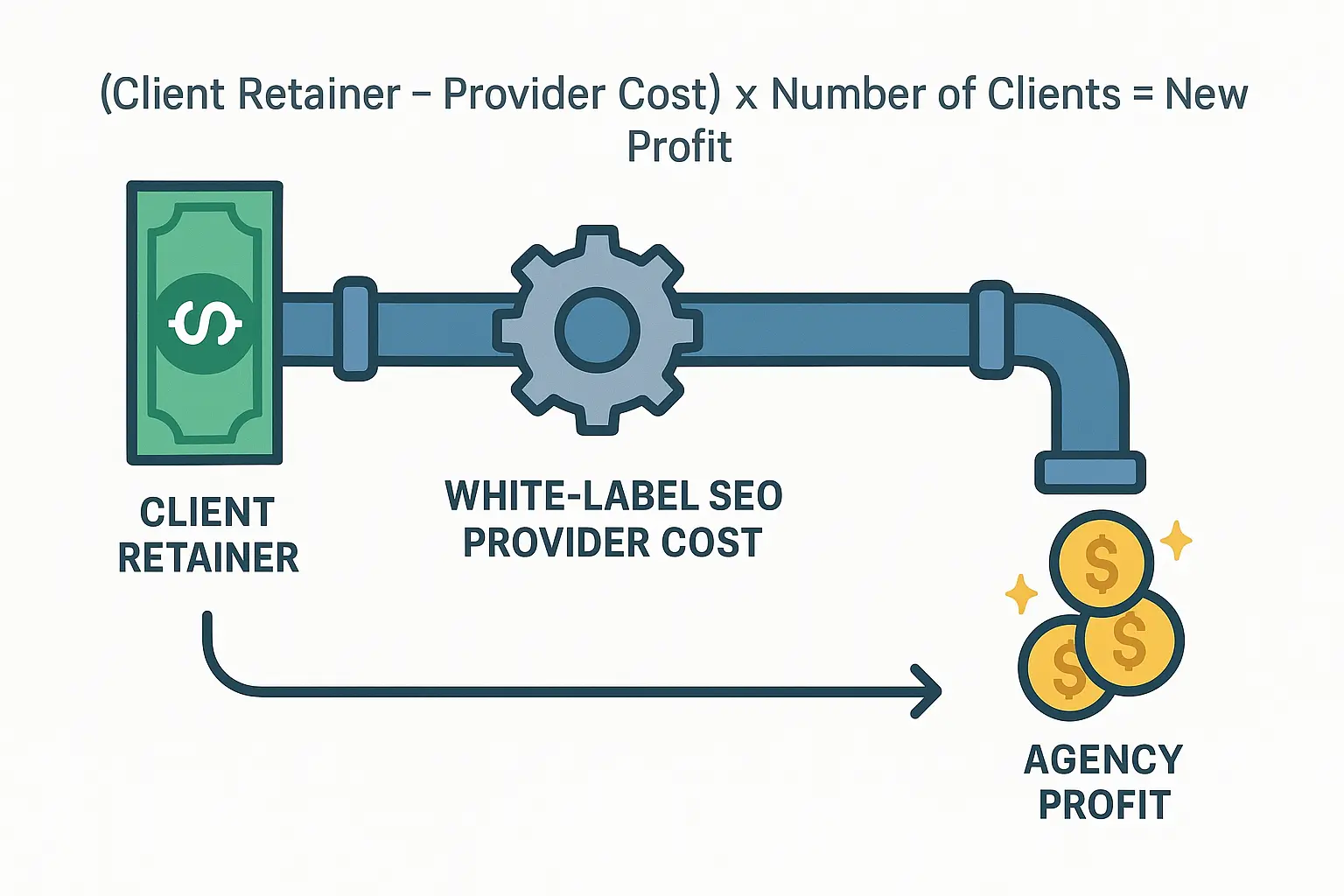You just launched a stunning new website for a client. The design is clean, the user experience is seamless, and they’re thrilled. Then comes the question that hangs in the air after every successful project: “This looks amazing. Now… how do we get people to actually see it?”
If you’re a web design, PPC, or creative agency, that question signals a massive and often untapped revenue opportunity. You’ve built the beautiful house, but your client needs help building the roads that lead to it.
For a long time, the answer was to refer them to an “SEO person.” But what if you could be the one to build those roads? It might seem complex, but adding SEO to your service line is more than just a new offering—it’s a fundamental shift toward more predictable, recurring revenue. In fact, research from Promethean Research shows that nearly 90% of agencies offer more than one service, moving away from single-threaded client relationships and toward integrated partnerships.
This guide is your blueprint for making that shift. We’ll break down how to forecast the profitability of adding SEO, turning a complex decision into a simple financial model.
Why SEO is the Natural Next Step for Your Agency
Your agency is already positioned as a trusted digital partner. When clients need to grow online, they look to you first. Adding SEO isn’t a pivot; it’s a logical extension of the value you already provide.
The demand is undeniable. According to HubSpot, a staggering 58% of marketers say improving SEO is their top inbound marketing priority. Your clients are part of that 58%—they’re already thinking about it, budgeting for it, and looking for a partner to help them.
Better yet, the market is wide open. Data from UpCity reveals that 63% of small businesses do not have an in-house SEO expert. They rely on external partners, and their first choice is often the agency they already know and trust—yours. By not offering SEO, you’re leaving a critical client need on the table for another agency to fill.
The Elephant in the Room: Building an SEO Team vs. Partnering
Once you decide to offer SEO, you face a critical crossroads: do you build an in-house team or partner with a specialist?
Building a team involves a significant upfront investment:
- Hiring Costs: Recruiting, interviewing, and onboarding SEO strategists, content writers, and link-building specialists.
- Salaries and Overhead: Competitive salaries (which are high for SEO talent), benefits, and software licenses can easily exceed six figures annually.
- Training and Management: SEO is constantly evolving. Your team needs ongoing training, and you need the expertise to manage their work effectively.
For most agencies just starting their SEO journey, this is a high-risk, high-cost path. The alternative is a partnership model. By using white-label SEO services, you can offer comprehensive SEO solutions under your own brand, powered by an expert team working silently in the background. This approach minimizes risk, eliminates overhead, and allows you to focus on what you do best: managing client relationships.

Modeling Your Agency’s SEO Profitability: A Step-by-Step Guide
Let’s get down to the numbers. How can you confidently forecast the revenue and profit from adding SEO? It’s simpler than you think.
Step 1: Understand the Profit Margins
The first “aha moment” for many agencies is realizing how profitable SEO services can be. Unlike project-based web design work, SEO is built on a recurring retainer model, creating a stable and predictable revenue stream.
According to research from Databox, agencies report profit margins between 20% and 60% for SEO services. This high margin is possible because a good white-label partner handles the heavy lifting, allowing you to price for value without carrying the massive overhead of an in-house team.
Step 2: Set Your Pricing Strategy
With healthy margins baked in, the next step is pricing. Data from Ahrefs shows the average retainer for agency SEO services falls between $1,000 and $4,000 per month. Where you fall in this range depends on the scope of work, your client’s industry, and your market.
Here are a few proven ways to structure your pricing:
- The Add-On: Offer a foundational SEO package as an optional add-on to every web design project. This is the easiest way to start, converting one-time projects into long-term relationships.
- The Standalone Retainer: Reach out to your past web design clients and offer them a standalone monthly SEO retainer to drive traffic to the site you built for them.
- The Bundled Package: Create an all-in-one “Website + SEO Launchpad” package for new clients. This positions you as a comprehensive growth partner from day one.
For your forecast, let’s pick a conservative starting point. A $2,000/month retainer is a common and highly achievable price point for a small business SEO package.
Step 3: Forecast Your First-Year Revenue
Now, let’s build a simple, realistic forecast. The goal isn’t to sign 50 SEO clients overnight but to build a sustainable, profitable service line.
Let’s assume a modest goal: You sign just one new SEO client per quarter.
Here’s what the math looks like:
Your Retail Price (per client): $2,000 / month
Your White-Label Partner Cost (example): -$800 / month
Your Gross Profit (per client): $1,200 / month
That’s a 60% profit margin per client, right at the top of the industry average.
Now, let’s map this out over your first year:
- End of Q1: 1 client = $1,200 / month in profit
- End of Q2: 2 clients = $2,400 / month in profit
- End of Q3: 3 clients = $3,600 / month in profit
- End of Q4: 4 clients = $4,800 / month in profit
By the end of your first year, with just four clients, you’ve added $57,600 in new, high-margin annual recurring revenue (ARR). By year two, that number could easily double or triple as your confidence and sales process mature.
One crucial part of this model is setting client expectations. As Google themselves note, it can take 6-12 months to see significant results from SEO. This is why the retainer model works so well—it aligns the engagement period with the time it takes to achieve meaningful outcomes.

Beyond the Numbers: The Hidden Benefits of Adding SEO
A profitable revenue forecast is compelling, but the strategic advantages of offering SEO run even deeper.
- Increased Client Lifetime Value (LTV): A client who pays you a monthly retainer for years is infinitely more valuable than a one-time project client.
- Enhanced Agency “Stickiness”: When you manage a client’s website and their primary source of traffic, you become an indispensable partner, drastically reducing churn.
- A Stronger Value Proposition: You’re no longer just a “web designer.” You’re a “growth partner” who delivers beautiful websites that also drive business results.
This approach allows you to truly scale SEO delivery without the operational headaches, making SEO outsourcing for agencies one of the most efficient paths to growth.
Frequently Asked Questions (FAQ)
How much should I charge for SEO?
Start by understanding your partner’s wholesale costs, then aim for a 50-60% margin. For a small business package, this often lands between $1,500-$3,000 per month.
Do I need to be an SEO expert to sell it?
Not at all. You need to understand the business value of showing up on Google and be able to articulate how it helps your clients achieve their goals—more leads, more sales, more visibility. Your white-label partner handles the technical execution and provides the data for your reports.
How do I explain the value of SEO to my web design clients?
Frame it this way: “We built you a world-class digital storefront. Now, we need to make sure the right customers can find their way to your front door. SEO is the system of roads, signs, and billboards that brings a steady stream of qualified visitors directly to you.”
What does a white-label partner actually do?
An invisible extension of your team, a white-label partner handles all the technical and strategic execution. This includes keyword research, on-page optimization, technical site audits, content creation, and authority building—all delivered under your agency’s brand.

Your Path to a More Profitable Future
Adding SEO to your service offerings isn’t just about chasing a new trend. It’s a strategic decision to build a more resilient, profitable, and valuable agency. By leveraging a partnership model, you can launch a new service line with minimal risk and position your agency as the long-term growth partner your clients are searching for.
Ready to see what this model could look like for your agency? Exploring how a partnership works is the first step toward transforming your revenue structure.

